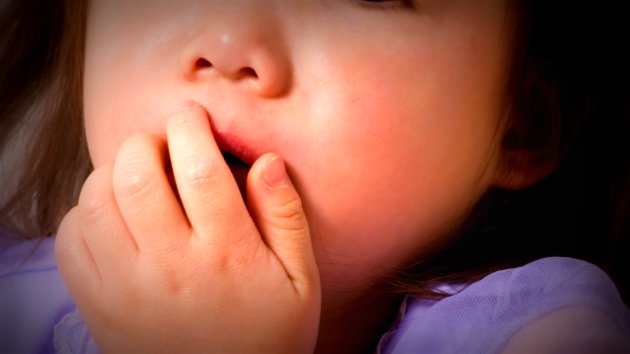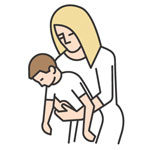
What to do when a child is choking?
Choking happens when someone’s airway suddenly gets blocked so they cannot breathe. Their airway can be partly or fully blocked. In children and babies, it can be caused if they put small objects in their mouths that then get stuck.
Step 1 Assess the situation
Are you dealing with
- A Baby under 1 Year?
- A Child over 1 year?
Step 2 Mild Choking or Severe Choking?
Mild Choking in a baby under 1 year
The sight of your infant coughing and sputtering on the bottle is frightening, but usually preventable.
A baby might choke during a feeding for a variety of reasons, ranging from a problem with the nipple to an issue with the way they have been positioned, for example; If a baby is feeding lying flat then they are more likely to choke.
If a baby is choking from their feed you should;
- Sit baby upright and support their head.
Useful Tip
When feeding, give regular breaks to allow baby to take a breath
Never leave your infant alone with a propped bottle as it’s a choking hazard.
Mild Choking in a child over 1 year
If the airway is only partly blocked, the child will usually be able to speak, cry, cough or breathe. In situations like this, a child over one year old will usually be able to clear the blockage themselves.
To help with mild choking in a child over one year old:
- Encourage the child to keep coughing to try to clear the blockage.
- Remove any obvious blockage from their mouth, using your first two fingers and thumb to grasp the object.
- Be ready to help in case their airway becomes fully blocked or the choking becomes severe.
Severe Choking
Where choking is severe, the child will not be able to speak, cry, cough or breathe. Without help, they will eventually become unconscious.
Severe Choking in a Baby under 1 year
A baby who is choking will be distressed and may be unable to cry, cough or breathe.
Important: do not use abdominal thrusts with babies under one year old.
- Lie the baby along your forearm on their back, with their head low, making sure you support their back and head.
- Give up to 5 chest thrusts. Using 2 fingers, push inwards and upwards (towards the head) against the baby’s breastbone, one finger’s breadth below the nipple line.
- Check if the blockage has cleared after each thrust, by looking inside the baby’s mouth and removing any obvious blockage.
Do not poke your fingers into the baby’s mouth unless you can see and reach the blockage as you may push it further in.
If the baby’s airway is still blocked after three cycles of back slaps and chest thrusts, you should:
-
Dial 999 for an ambulance immediately. Do not leave the baby – take him or her with you to the phone
- continue with the cycles of back slaps and chest thrusts until help arrives
Severe Choking in a Child over 1 year
To help a child over one year old who is choking severely:
- Stand slightly behind the person to one side. If you’re right-handed, stand to the left. If you’re left-handed, stand to the right.
- Support their chest with one hand. Lean the person forward so that the object blocking their airway will come out of their mouth, rather than going further down.
- Give up to five sharp blows between the person’s shoulder blades with the heel of your hand. (The heel is between the palm of your hand and your wrist.)
- Stop after each blow to check if the blockage has cleared.
- If not, give up to five abdominal thrusts (see below).
- Stop after each thrust to check if the blockage has cleared.
If the person’s airway is still blocked after three cycles of back blows and abdominal thrusts, you should send for help:
-
Dial 999 for an ambulance immediately.
- Continue with the cycles of back blows and abdominal thrusts until help arrives.
New T.V Ad shows parents how to save a choking baby
The campaign by St John Ambulance, dubbed The Chokeables, sees the actors play objects that could cause babies to choke – a small princess toy, a chewed-up pen lid, a jelly baby and a peanut.
It comes as new research shows that four-fifths of parents (79 per cent) do not know the correct technique despite more than half (58 per cent) saying that choking is a major fear for them and 40 per cent that they have witnessed it.
Chief Executive of St John Ambulance Sue Killen, said: “Knowing what to do in an emergency can be the difference between life and death, especially with something like choking”.
“We all know how time-pressed parents are so this film makes it as easy as possible to learn first aid – in less than 40 seconds we can all know a skill that could save a life”.
“We hope people watch and share the video with their friends and family so more people have the confidence to act in an emergency.”
Get blog updates by email
Enter your detials:
Get updates by email
Enter your detials:


